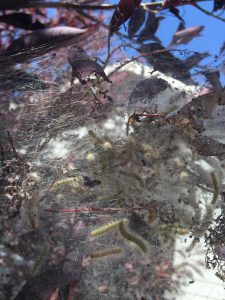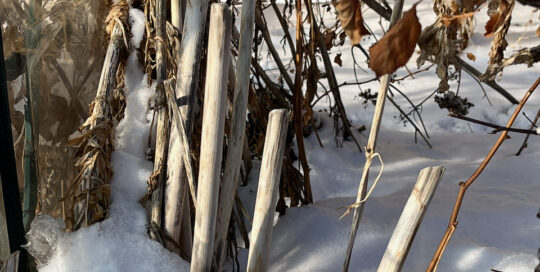Eastern tent caterpillars, bagworms, and fall webworms
Views: 8450

It’s fairly common at nearly any time of the year to notice a lace-like looking web forming on parts of a tree or shrub. But even though the initial appearance might be the same, the culprits can be very different species. Eastern tent caterpillars, bagworms, and fall webworms all create similar looking weblike structures, and it’s important to know the difference.
The bagworms (Thyridopteryx ephemeraeformis) are predominantly in the eastern part of the United States. They can usually be found on evergreens such as pines, arborvitae, and spruce, but might also target honey locust and sycamores. They create silk structures hanging from and among branches where the larvae feed and grow. The trouble with bagworms is they tend to be a little more inconspicuous until the group of bagworms is large enough to already caused damage. This can be more problematic in the evergreens that have a more difficult time rebounding from an infestation.
Removing Bagworms
To be rid of them, one of the easiest methods for smaller trees and shrubs is to prune them out. If this isn’t an option, and it’s still early in the season, you can spray them with Sevin, or a similar product. But if they are fully developed, chemicals may have little or no effect.
In other parts of the country, springtime web creating caterpillars are typically the eastern tent caterpillar (Malacosoma americanum). They form their silky nest in the crooks of trees and shrubs early in the spring to feed and grow. While they’re on the tree they can defoliate it and weaken it. Although, in most years their numbers are not large enough to do significant damage. Most will regrow leaves and do just fine the rest of the season. Once they’re mature, they will typically leave the nest on a regular basis to feed and come back in the evening.
The trick to keeping these caterpillars in check is to catch them early. They overwinter as eggs on the host tree or shrub on branches that are about the diameter of a pencil. Don’t look for the web at this time, though. They are typically plastered to the branch with a varnish-like substance. Using a dormant oil spray in the spring is the best way to stay on top of them.
Webworms
As summer winds down, it’s more likely you’re seeing fall webworms (Hyphantria cunea). They form at the end of the branches of deciduous trees and shrubs instead of in the crooks of them. They don’t attack evergreens. While they are not necessarily a significant pest, these are a lot easier to eliminate, as long as you can reach them. You can simply snip off the ends of the branches. And if the caterpillars are still small, Bt (Bacillus thuringiensis) is effective against them, as well as the heavier duty chemical pesticides.
Use these methods if the nest is growing too large or is unsightly. They do tend to become rather large some years. One difference between tent caterpillars and webworms is the tent caterpillars leave the nest to feed, while the webworms remain within the nest, expanding it as they need, impacting the shrub more due to the size of the nest.
While bagworms, eastern tent caterpillars, and fall bagworms can be kind of unsightly, they’re typically not detrimental to the trees or shrubs. Use the least invasive measure in the first steps of controlling them. If you want to eliminate, or at least reduce, the issue next year, plan on spraying your trees and shrubs in the spring to keep these webby worms at bay.
The photo is from my friend, Kelly Speidel, who has a bit of an issue with webworms this year.
Meet Amy Grisak
Amy is a freelance author and photographer in Great Falls, MT who specializes in gardening, foods, and sustainable agriculture. She provides information on every kind…
Amy's Recent Posts

This Little Piggy is a Problem: Dealing with Feral Hogs








